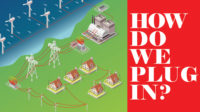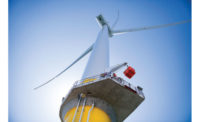Renewable Energy
Siemens Scores Big U.S. Play for New Record Wind Turbine

European wind turbine manufacturer Siemens Gamesa announced May 26 what could be the first U.S. installation of its just-unveiled giant 14-MW to 15-MW offshore wind model at Virginia Dominion Energy's planned 2,640-MW offshore wind project, under an agreement with the utility that is subject to a final investment decision. The project would be located 27 miles offshore of Virginia Beach, Va.
Siemens Gamesa is considering whether to build a large manufacturing plant at a close onshore site, possibly Hampton Roads, Va., for what would be industry-leading 108-m-long blades, and it will decide within a year on sourcing and a supply chain to serve the U.S. market, it says.
Other East Coast states, particularly Massachusetts, New York and Maryland, also are competing to site a major offshore wind manufacturing hub as projects proceed.
The development adds a new edge to the competitive mega-turbine market in the U.S. and globally, which had seen GE Renewables take a leading role over the last two years with its launch of the 12-MW Haliade-X turbine, the current size record holder. The 220-m-dia. turbine will power the 3.6GW Dogger Bank offshore wind project in the U.K., which began construction in January and now is set to be the world's largest, as well as projects planned for Maryland and New Jersey, among others.
Siemens has been working with local stakeholders for some months. “With this agreement and this new product, we are positioned to significantly advance the growth of the industry and provide clean energy for many generations to come,” says Steve Dayney, who heads the company’s renewable division in North America.
Va. Ups Clean-Energy Goal
Dominion announced the large commercial project last September, set to be completed by 2026, and on May 1 nearly doubled its offshore wind energy plans to 5,100 MW by 2035. The move comes just three weeks after Gov. Ralph Northam (D) signed the Virginia Clean Economy Act, which commits the state to 100% zero-carbon electricity by 2045.
“Based on our current estimates for fully installed costs, which we expect will reduce over time, offshore wind represents between $8 billion and $17 billion of capital investment over the next 15 years,” Dominion CEO Thomas Farrel said in a May 5 corporate results call.
Survey work for the 2,640-MW project, the largest offshore wind farm planned so far in the U.S., is expected to begin this year, with a construction and operations plan submitted to federal regulators at the Bureau of Ocean Energy Management.
Separately, Farrell confirmed that Dominion is leading a consortium to build an offshore wind installation vessel that complies with the federal Jones Act, which requires goods shipped between U.S. ports to be carried on domestically owned vessels.
The vessel will be able to install next-generation turbines such as the new Siemens units, which reduce construction and maintenance costs, he said. Funded by consortium participants, including Dominion Energy, it will enter service in 2023 and operate continuously for several years under contracts with multiple major US offshore wind developers, Farrell said.
Consortium members were not made public. Farrell also did not discuss the vessel’s cost.
Offshore Wind Demo Project Proceeds
Dominion now is building with its partner, Danish developer Orsted, a 12-MW, two-turbine offshore wind demonstration project adjacent to the planned commercial site. Foundations were installed the week of May 25 and turbines are next in mid-June, Dominion says.
Based on the pilot's degree of success after expected completion later this year, the utility will move forward with the commercial project in three 880-MW phases. The initial phase would come on line in 2024 with the next two in 2025 and 2026. Dominion says it will leverage its experience with permitting, design and development of the pilot to develop the commercial project.
With a 222-m rotor diameter, the Siemens 14-MW turbine has the capacity to produce about 25% more energy than the firm's current 11-MW turbine, the company says.
The new turbine has a comparatively low nacelle weight of 500 metric tons, which allows Siemens Gamesa to reduce machine cost by minimizing sourced materials and transportation expenses, the company says. Each blade is cast in one piece using patented blade technologies. The number of turbines to be used in Dominion’s commercial project depends on site conditions.
The company’s standardized processes and fully developed supply chain have reduced the new turbine’s time to market, with serial production planned for 2024, Siemens says.
The company also said May 26 that its 14-MW turbine will be used at Taiwan’s 300-MW Hai Long 2 project and is under consideration for an additional 1,044-MW there. The decision depends on final investment decision by developers Northland Power, a Canadian company, and Taiwan-based Yushan Energy.
Meanwhile, Siemens says it is proceeding with plans announced last year to spin off its energy manufacturing business in an initial public offering (IPO) set for Sept. 28, to allow it to focus on its factory automation, smart building and transportation manufacturing businesses.
If executed, the IPO would be one of the largest this year, with many spinoffs curtailed by the COVID-19 pandemic, said Reuters. The energy unit had revenue of about $31.8 billion last year but the total was down 4% with the changing fossil-fuel market, and profit fell 7%.
Clean-Energy Tax Credits Expand
In other anticipated clean-energy market developments, the U.S. Treasury on May 27 extended the deadline for renewable energy projects to take advantage of certain tax credits. With the change, projects that started construction in 2016 or 2017 now have an extra year to go into service and still gain the credit. Developers also now have more time, in some cases, to receive construction materials in order to start building.
Gregory Wetstone, president and CEO of the American Council on Renewable Energy, called the measure an important step to help the renewables sector and its workers in the face of delays, disruptions and other challenges linked to COVID-19. He called on Congress to take other steps to make renewable energy a post-virus driver of economic recovery.
“The federal government needs to extend these tax credits further so that new projects can qualify. This will help protect green jobs and move us closer to 100% renewable and zero-carbon by 2050,” says Jeff Tittle, director of the New Jersey Sierra Club.
Also, on May 28, the U.S. Internal Revenue Service proposed long-awaited rules that detail how companies can qualify for carbon-capture tax credits by demonstrating that they have securely stored or disposed of carbon removed from the atmosphere.
The guidance also notes how and when the government can reclaim the incentive if projects fall short of requirements and how to account for emissions reductions from carbon stored in products.
The tax-credit was enacted into law in 2018 but not widely used by project developers because of uncertainty related to the delay in detailed IRS rules.
A U.S. Treasury Dept. Inspector General's office report in April said the IRS has disallowed about $531 million in claimed tax credits.






